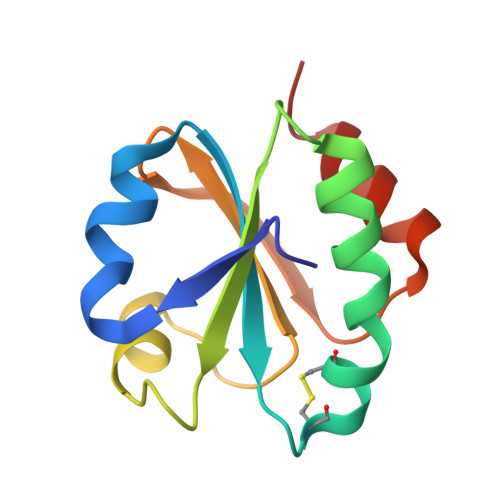Loop size optimization induces a strong thermal stabilization of the thioredoxin fold.
Ruggiero, A., Smaldone, G., Esposito, L., Balasco, N., Vitagliano, L.(2019) FEBS J 286: 1752-1764
- PubMed: 30675750
- DOI: https://doi.org/10.1111/febs.14767
- Primary Citation of Related Structures:
6H1Y - PubMed Abstract:
The definition of the structural basis of protein thermostability represents a major topic in structural biology and protein chemistry. We have recently observed that proteins isolated from thermophilic organisms show a better adherence to the fundamental rules of protein topology previously unveiled by Baker and coworkers (Koga et al. Nature. 2012; 491: 222-227). Here, we explored the possibility that ad hoc modifications of a natural protein following these rules could represent an efficient tool to stabilize its structure. Hence, we here designed and characterized novel variants of Escherichia coli thioredoxin (EcTrx) using a repertoire of biophysical/structural techniques. Trx chimeric variants were prepared by replacing the loop of EcTrx with the corresponding ones present in the Trxs isolated from Sulfolobus solfataricus and Sulfolobus tokodaii that show a better adherence to the topological rules. Interestingly, although the loop sequences of these proteins did not display any significant similarity, their insertion in EcTrx induced a remarkable stabilization of the protein (≥10 °C). The crystallographic structure of one of these variants corroborates the hypothesis that the optimization of the loop size is the driving force of the observed stabilization. The remarkable stabilization of the two novel chimeric Trxs, generated by applying the topological rules, represents the proof of concept that these rules may be used to stabilize natural proteins through the ad hoc optimization of the loop size. Based on the present results, we propose a novel protocol of protein stabilization that can be potentially applied to other proteins.
Organizational Affiliation:
Institute of Biostructures and Bioimaging, C.N.R., Naples, Italy.














